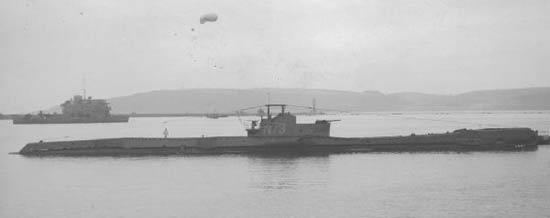Laid down 21 November 1938 Launched 9 April 1940 Draft 4.97 m | Commissioned 14 January 1941 Construction started 21 November 1938 Length 84 m | |
 | ||
Fate sold for breaking up 19 November 1945,scrapped March 1947 | ||
HMS Torbay (N79) was a T-class submarine of the Royal Navy. She was laid down at Chatham Dockyard and launched on 9 April 1940.
Contents
- Service history
- Mediterranean
- Home waters
- Return to the Mediterranean
- Far East
- Post war
- Raiding career
- Publications
- References
Torbay had an active career, serving mainly in the Mediterranean, although she also served in the Pacific Far East at the end of the war.
Altogether she sank 17 merchant ships, totalling 38,000 tons, plus 5 warships and 24 sailing vessels, and was involved in an attack on Corfu harbour that won her captain, Lieutenant Commander (Lt. Cdr.) Anthony Miers, the Victoria Cross.
Torbay was also involved in two incidents alleged to be war crimes.
Service history
Torbay was commissioned on 14 January 1941, under the command of Lt. Cdr. Anthony Miers.
In March 1941 she sailed from Portsmouth on her first offensive patrol, to intercept the battleships Scharnhorst and Gneisenau, which were heading for Brest after their raiding sortie in the North Atlantic. Unable to find them, Torbay was ordered to continue to Gibraltar, and, after another patrol in the Mediterranean, to join the 1st Flotilla at Alexandria.
Mediterranean
From there, Torbay operated for the next 12 months, sinking a number of ships and taking part in several special operations.
In July 1941, on her first patrol from Alexandria, Torbay was involved in two incidents which gave rise to allegations of war crimes. It is alleged that on two occasions after sinking enemy ships, Miers had Torbay's crew fire on troops as they swam in the water. Miers made no attempt to hide his actions and reported it in his official logs. He received a strongly worded reprimand from the Royal Navy after the first incident.
Torbay was involved in attacks on Axis convoys on two occasions. The attack on the first, on 10 June 1941 involved Torbay making three attack runs on an Italian convoy off the Dardanelles. The first attack failed to produce any results; the second attack resulted in a torpedo hit on the Italian tanker Utilitas but the torpedo failed to explode. In the third attack the Italian tanker Giuseppina Ghirardi was torpedoed and sunk. The attack on the second convoy took place on 12 August 1941, west of Benghazi, Libya. Torbay fired on the Italian merchant ships Bosforo and Iseo but missed both. Torbay was heavily depth charged after these attacks.
In November 1941 Torbay was tasked with landing a party of commandos, under Geoffrey Keyes, for the ill-fated Operation Flipper. On 15 December 1941 Torbay torpedoed an Italian merchant ship in German service, Sebastiano Veniero, at Methoni in the Peloponnese. Sebastiano Veniero was already beached after having been damaged a week earlier by a torpedo fired by the Grampus-class submarine HMS Porpoise.
On 4 March 1942 in Corfu Harbour, north-western Greece, Torbay, having followed an enemy convoy into the harbour the previous day, fired torpedoes at a destroyer and two 5,000 ton transports, scoring hits on the two supply ships, which almost certainly sank. Torbay then had a very hazardous withdrawal to the open sea, enduring 40 depth-charges. The submarine had been in closely patrolled enemy waters for 17 hours. For this exploit, her commander, Lieutenant Commander Anthony Miers was awarded the Victoria Cross.
Home waters
In mid-1942 Torbay returned to Britain. She returned to the Mediterranean in February 1943 under the command of Lieutenant (Lt.) Robert Clutterbuck.
Return to the Mediterranean
Back in the Mediterranean, Torbay carried out a further series of successful patrols. She also had a close encounter with the German Q-ship GA 45. In October 1943 Torbay's periscope was sighted first by GA 45 which dropped depth-charges very close to Torbay. The submarine later surfaced, intending to attack GA 45 with her deck gun but the German vessel opened fire and forced her to break off the action. GA 45 did not drop any further depth-charges (perhaps having run out). Torbay managed to escape damage during this encounter.
As the war in the Mediterranean quieted, Torbay was again reassigned, this time to the Pacific Far East.
Far East
Arriving in May 1945, and under the command of Lt. C.P. Norman, Torbay continued to cause losses amongst enemy shipping. She sank two Japanese sailing vessels and a coaster, and damaged a second coaster, before the end of the war.
Post war
Having survived the war, Torbay was sold on 19 December 1945 and scrapped at Briton Ferry, Wales in March 1947.
Raiding career
Torbay attacked and sank the following ships:-
Torbay also damaged the following ships:-
